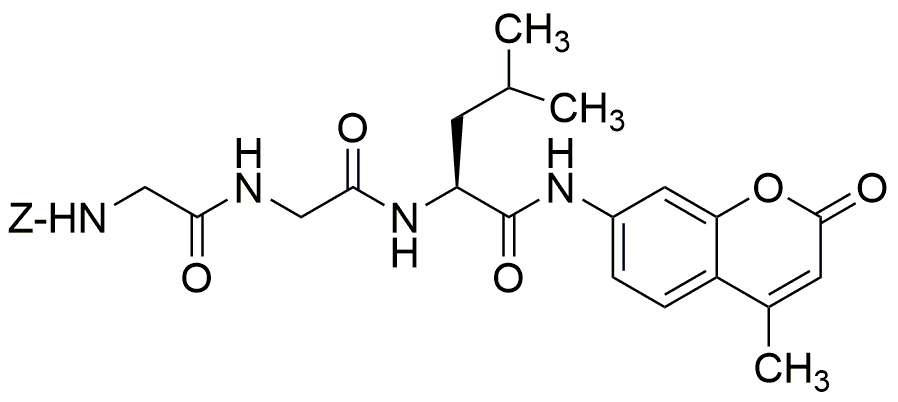Z-Gly-Gly-Leu-AMC is widely utilized in research focused on:
- Protease Activity Assays: This compound serves as a substrate in assays to measure protease activity, allowing researchers to study enzyme kinetics and inhibition in various biological processes.
- Drug Development: It plays a crucial role in the pharmaceutical industry for screening potential drug candidates that target specific proteases, aiding in the development of therapies for diseases like cancer and viral infections.
- Biochemical Research: Researchers use it to investigate protein interactions and post-translational modifications, enhancing our understanding of cellular mechanisms and signaling pathways.
- Fluorescence Microscopy: The compound can be employed in fluorescence microscopy to visualize protease activity in live cells, providing insights into cellular functions and disease states.
- Biotechnology Applications: In biotechnology, it is used in the development of biosensors and diagnostic tools, facilitating the detection of specific proteases in clinical samples.
General Information
Properties
Safety and Regulations
Applications
Z-Gly-Gly-Leu-AMC is widely utilized in research focused on:
- Protease Activity Assays: This compound serves as a substrate in assays to measure protease activity, allowing researchers to study enzyme kinetics and inhibition in various biological processes.
- Drug Development: It plays a crucial role in the pharmaceutical industry for screening potential drug candidates that target specific proteases, aiding in the development of therapies for diseases like cancer and viral infections.
- Biochemical Research: Researchers use it to investigate protein interactions and post-translational modifications, enhancing our understanding of cellular mechanisms and signaling pathways.
- Fluorescence Microscopy: The compound can be employed in fluorescence microscopy to visualize protease activity in live cells, providing insights into cellular functions and disease states.
- Biotechnology Applications: In biotechnology, it is used in the development of biosensors and diagnostic tools, facilitating the detection of specific proteases in clinical samples.
Documents
Safety Data Sheets (SDS)
The SDS provides comprehensive safety information on handling, storage, and disposal of the product.
Product Specification (PS)
The PS provides a comprehensive breakdown of the product’s properties, including chemical composition, physical state, purity, and storage requirements. It also details acceptable quality ranges and the product's intended applications.
Certificates of Analysis (COA)
Search for Certificates of Analysis (COA) by entering the products Lot Number. Lot and Batch Numbers can be found on a product’s label following the words ‘Lot’ or ‘Batch’.
*Catalog Number
*Lot Number
Certificates Of Origin (COO)
This COO confirms the country where the product was manufactured, and also details the materials and components used in it and whether it is derived from natural, synthetic, or other specific sources. This certificate may be required for customs, trade, and regulatory compliance.
*Catalog Number
*Lot Number
Safety Data Sheets (SDS)
The SDS provides comprehensive safety information on handling, storage, and disposal of the product.
DownloadProduct Specification (PS)
The PS provides a comprehensive breakdown of the product’s properties, including chemical composition, physical state, purity, and storage requirements. It also details acceptable quality ranges and the product's intended applications.
DownloadCertificates of Analysis (COA)
Search for Certificates of Analysis (COA) by entering the products Lot Number. Lot and Batch Numbers can be found on a product’s label following the words ‘Lot’ or ‘Batch’.
*Catalog Number
*Lot Number
Certificates Of Origin (COO)
This COO confirms the country where the product was manufactured, and also details the materials and components used in it and whether it is derived from natural, synthetic, or other specific sources. This certificate may be required for customs, trade, and regulatory compliance.


